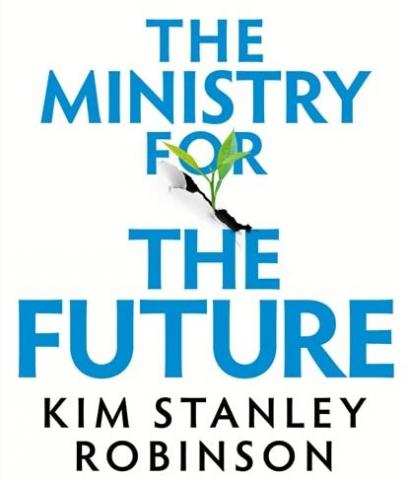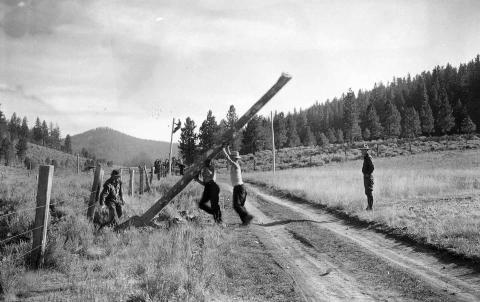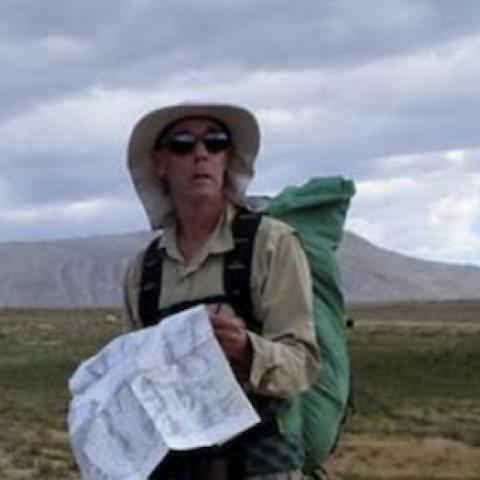2020 would have been the year of two very important United Nations Conventions of Parties, one by the Convention on Biological Diversity and one by the Framework Convenion on Climate Change, five years after the landmark Paris Agreement; both have been pushed to 2021 because of Covid-19. As 2020 draws to a close, civilization again starts looking beyond the short-term crisis into the wider and longer-term threat of climate change and biodiversity loss. And Kim Stanley Robinson's The Ministry for the Future is there to synthesize the issue, make us feel interconnected, and make us envision a pathway to a better world.
(Image: KSR, from LARB.)
Stan's regular column for Bloomberg Green continues, with "Slowing Climate Change With Sewage Treatment for the Skies", about biological and technological ways to suck carbon from the air:
The problem isn’t technical viability but the giant investment required to build something that may not yield a profit. There’s promise in developing liquid fuels made with captured CO₂ or turning the primary greenhouse gas into feedstock for various carbon fibers. But the amount of carbon we need to draw down far exceeds these industrial uses, and capital seeking the highest rate of return won’t get invested.
KSR's interview with Ezra Klein at Vox is a must-listen! Klein calls Ministry "The most important book I’ve read this year" and their conversation goes to the crux of Robinson's thinking and the significance of his work for literature and positive change. Klein summarizes:
This conversation with Robinson was fantastic. We discuss why the end of the world is easier to imagine than the end of capitalism; how changes to the biosphere will force humanity to rethink capitalism, borders, terrorism, and currency; the influence of eco-Marxism on Robinson’s thinking; how existing power relationships define the boundaries of what is considered violence; why science fiction as a discipline is particularly suited to grapple with climate change; what a complete rethinking of the global economic system could look like; why Robinson thinks geoengineering needs to be on the table; the vastly underrated importance of the Paris climate agreement, and much more.
Everett Hamner conducted an extensive interview with KSR for the Los Angeles Review of Books: "Odd Couples, Carbon Coins, and Narrative Scopes". How to insititue change, the role of violence, the source of recurring character names in KSR's novels (like Frank or Charlotte), autobiographical parts in Green Earth, narrative modes, the narcissism of small differences in politics, the balance of power between politics and banks and money, religion, and more are discussed in a vivid intellectual back and forth. A small sample:
One change in my thinking came after finishing Red Moon, with the feeling I needed to go right to the heart of the story and not work on the margins any longer. (The moon is particularly marginal.) Another was the very strong impression that if, or when, people suffer a bad enough climate disaster, things will change. Then I began imagining a future history that felt real and yet ended up in some kind of “best case scenario” space — that was my challenge for this project. Then it seemed inevitable that chaos and violence were going to be part of the story. If I sometimes thought of it as a coming revolution, it still seemed clear it was also going to be a giant mess — all kinds of different revolutions at once, adding up to a violent set of spasms out of anyone’s control — something like Williams’s “long revolution,” narrated as a slurry. That struck me as accurate to how even a best-case scenario would play out, and it was also a formal challenge and opportunity, for game-playing in the novel as formal construct.
[...] Money is a public utility, banks are badly run credit unions, a nationalized bank system would make money into something you get access to for a fee that you pay to the public treasury — and so on, like that. This sounds weird until you reflect it’s almost like that already; it’s just been mystified by predatory rent-seekers pretending things are different in such a plausible way that current legislation tends to skew toward their interpretation of these large structures. Finance has been made so complicated that legislators turn to financiers to craft financial legislation, because the legislators are scared they don’t understand it. But good financial advice can come from the left as well as the right, and ultimately it’s still very simple — a power dynamic. And people seizing power from a privileged minority is the long arc of history. A better story changes politics, then laws.
[...] I’m interested in the Ur-religion of shamanism, which is probably over a hundred thousand years old, and came out of Africa when people did; and in all the ones you listed above, Buddhism in particular. And then also science as a kind of devotional practice that regards the real as a sacred object of study; isn’t that a religion? And when I’m in the Sierras I often feel something ineffable, some kind of holiness. I think almost everyone has these feelings, and not having them would be bad; it would constitute a kind of lack or crisis.
KSR was also interviewed by Rolling Stone! The result is a fast interview with much shorter sentences than the previous interview: "What Will the World Look Like in 30 Years? Sci-fi Author Kim Stanley Robinson Takes Us There". Select bits:
I am a leftist, an American leftist, and I’m saying just as a practicality that overthrowing capitalism is too messy, too much blowback, and too lengthy of a process. We’ve got a nation-state system and a financial order, and we’ve got a crisis that has to be dealt with in the next 10 to 20 years. So I’m looking at the tools at hand. Tax structures, sure. And essentially, I’m talking about a stepwise reform that after enough steps have been taken, you get to something that is truly post-capitalist that might take huge elements from the standard socialist techniques.
I love the Green New Deal. I love HR109 [the Green New Deal resolution introduced by Rep. Alexandria Ocasio-Cortez]. That’s really a smart document. It’s not naïve. It’s not primitive. It’s a fully articulated plan that takes in a lot of social elements that are very smartly done. So this is not a naïve crowd. There’s something hubristic about the phrase geoengineering, and it looks like a Silicon Valley techno silver-bullet fix that is against the grain of the total program that the left is insisting on, which I totally agree with.
In another interview for The Nation, "Kim Stanley Robinson Bears Witness to Our Climate Futures", Stan talks about California fires, the Coronavirus pandemic, Black Lives Matter, and more. Select bits:
[On work and laboring in his novels] I think the right to work, the dignity to work, and the idea that it’s actually bad not to have work is a post-Marx or 20th century development. The bourgeois novel is famous for not being able to write about work because it’s too boring. The story of work is the repetition of things that ultimately go right, and only when things go wrong do you have a plot. The novel isn’t well suited to describe the repetition and the interests of work per se. In Red Mars, the idea of building a town has drama to it because it’s on an inhospitable new planet; the work can be described and be of interest as a plot. In Ministry for the Future, the work is everybody shifting their lives to decarbonization, and the technocracy of the ministry itself as a form of work. We’re all working on the project, part of the machine.
[On animal rights] For a long time, it’s been a very vexed topic for me. I’d say that there was a split on the left between environmentalists and human-centric leftists. The one side seemed to regard nature as just the raw material for humans, and that was incredibly anthropocentric, and the other was often accused of being a bourgeois ideology of people comfortable enough to worry about the natural world and the whales. So, on that divide I was always a green, but it seemed to me as a leftist, the two were the same. People talk about the European greens having red roots or there’s watermelon people who are green on the outside but red on the inside. This is to create a distinction that is just a bad split of two forms of anti-capitalism. And when you regard nature as our extended bodies, the first biosphere is the human being. For either to thrive, both have to thrive. Certainly for humans to thrive, the biosphere has to thrive.
Hightech/Highsnobiety has an original interview with KSR, a "Rorschach test of subjects to pontificate on", where KSR responds to key words: "The Science Fiction of Right Now". Sample:
California
My home state is a strange place. It’s some kind of culmination to American history, in that many people kept moving west until they had to stop. And where they stopped was a very unusual landscape with a great amount and variety of terrains and climates. A biological hot spot, even though it doesn’t have much water compared to places with more rainfall and what would be needed to supply the needs of its almost 40 million people. Its water is distributed around the state by way of a system, so you could say it’s a terraformed space.
Add to that a very strange history, including the original gold rush, Hollywood’s movie industry, and Silicon Valley’s computer industry — these combine to make for a freakish place, a magical name and idea in world history. Possibly all these blessings add up to a curse, but at least California will always have its Sierra Nevada, one of the great mountain ranges of the world and one of my favorite places to be.
Slate has a summary of New America event on November 10, with bits from KSR, Peter Schlosser (ASU) and Malka Older (SF author), "Imaging a “Future of Opportunity”—and Governing Toward It":
And to do so, said Robinson, we have to get creative in the ways we imagine and share our blueprints for the future.
“If storytelling itself is going to be adequate to this global situation that is beyond any one individuals’ comprehension,” he said, “then you have to just throw caution to the wind and try to make up new forms and tell stories that actually reflect this dynamic moment that we’re in.”
The December 2020 print edition of Locus has an interview with KSR: "Forward the Future". Some excerpts are available online:
Most of what I wrote about in The Ministry for the Future is already out there in the world. I did very little extrapolating of technology. The book’s plan for slowing down Antarctic glaciers is the idea of an individual glaciologist who shared it with me, telling me he didn’t want to talk in public about it because he didn’t want to get dragged into the geoengineering wars. [...] The other important part of my plot, the carbon coin, comes out of a paper I ran into online, by Delton Chen.
Two more video interviews in this prolific time:
KSR with Christopher Tucker (of the American Geographical Society) for Geography 2050.
KSR with Josh Fox for The Young Turks.
Book excerpt! Regen Network, an effort to align economics with carbon drowdown in land management (and on whose real-world work the list of initiatives in Chapter 85 is based on), has Chapter 80 available online -- farmers transitioning to regenerative agriculture and get paid in carbon coin for it.
Book clubs! As he did for New York 2140, Bryan Alexander is running a book club on The Ministry for the Future over several weeks, and Part 1 and Part 2 are already up; it comes recommended (twice!) by Joshua Kim at Inside Higher Ed, in the form of mini-reviews. And of course Matt and Hilary's podcast is continuing strong.
Reviews and recommendations in "Best of 2020" lists, both professional and semi-professional:
And, last but not least, Barack Obama himself in his Favorite Books of 2020! Here's to a progressive 2021!





